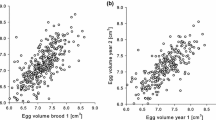Abstract
Extrapair fertilizations are an important factor in reproduction of many bird species. It has been suggested that pursuit of extrapair fertilizations provides a selective pressure capable of affecting the “ecological” attributes of some bird species. It is known that in some cases the pursuit of extrapair copulations is motivated by fertility assurance. That is, there are populations in which (i) some males and females cannot produce viable offspring, and (ii) there is no pre-copulatory way to choose a compatible mate. In such situations individuals mate for “economic” reasons and attempt to secure reproduction by copulating with multiple partners. Here we formulate and analyze a simple game theoretical model addressing the interplay between environmental constraints and the pursuit of fertility assurance via extrapair copulations in determining breeding synchrony. Our results indicate that breeding synchrony in such cases is determined by the magnitude of the costs (due to environmental constraints) of breeding asynchronously versus the worth of the attendant increase in extrapair opportunities.
Similar content being viewed by others
References
Birkhead, T.R., Møller, A.P., 1992. Sperm Competition in Birds: Evolutionarily Causes and Consequences. Academic Press, New York.
Birkhead, T.R., Pizzari, T., 2002. Postcopulatory sexual selection. Nat. Rev. Genet. 3, 262–273.
Chuang-Dobbs, H.C., Webster, M.S., Holmes, R.T., 2001. The effectiveness of mate guarding by male black-throated blue warblers. Behav. Ecol. 12, 541–546.
Fishman, M.A., Lotem, A., Stone, L., 2003. Fertility assurance through extrapair paternity, and male paternity defense. J. Theor. Biol. 221, 103–114.
Griffith, S.C., Owens, I.P.F., Thuman, K.A., 2002. Extra pair paternity in birds: a review of interspecific variation and adaptive function. Mol. Ecol. 11, 2195–2212.
Hofbauer, J., Sigmund, K., 1988. Evolutionarily Games and Population Dynamics. Cambridge University Press, Cambridge (Section-15).
Jeffreys, A.J., Wilson, V., Thein, S.L., 1985. Hypervariable “minisatellite” regions in human DNA. Nature 314, 67–73.
Kempenaers, B., Congdon, B., Boag, P., Robertson, R.J., 1999. Extrapair paternity and egg hatchability in tree swallows: evidence for the genetic compatibility hypothesis? Behav. Ecol. 10, 304–311.
Krokene, C., Rigstad, K., Dale, M., Lifjeld, J.T., 1998. The function of extrapair paternity in blue tits and great tits: good genes or fertility insurance? Behav. Ecol. 9, 649–656.
Lack, D., 1968. Ecological Adaptations for Breeding in Birds. Chapman and Hall, London.
Møller, A.P., Briskie, J.V., 1995. Extra-pair paternity, sperm competition and the evolution of testis size in birds. Behav. Ecol. Sociobiol. 46, 357–365.
Saino, N., Primmer, C.R., Ellegren, H., Møller, A.P., 1999. Breeding synchrony and paternity in the barn swallow (Hirundo rustica). Behav. Ecol. Sociobiol. 45, 211–218.
Schwagmeyer, P.L., Ketterson, E.D., 1999. Breeding synchrony and EPF rates: the key to a can of worms? Trends Ecol. Evol. 14, 47–48.
Strohbach, S., Curio, E., Bathen, A., Epplen, J.T., Lubjuhn, T., 1998. Extrapair paternity in the great tit (Parus major): a test of the “good genes” hypothesis. Behav. Ecol. 9, 388–396.
Wagner, R.H., 1993. The pursuit of extra-pair copulations by female birds—a new hypothesis of colony formation. J. Theor. Biol. 163, 333–346.
Welty, J.C., 1982. The Life of Birds, 3rd edition. Saunders, Philadelphia and London, pp. 171–178.
Westneat, D.F., Gray, E.M., 1998. Breeding synchrony and extrapair fertilizations in two populations of redwinged blackbirds. Behav. Ecol. 9, 456–464.
Author information
Authors and Affiliations
Corresponding author
Rights and permissions
About this article
Cite this article
Fishman, M.A., Stone, L. Fertility assurance and breeding synchrony. Bull. Math. Biol. 67, 875–883 (2005). https://doi.org/10.1016/j.bulm.2004.11.004
Received:
Accepted:
Issue Date:
DOI: https://doi.org/10.1016/j.bulm.2004.11.004




